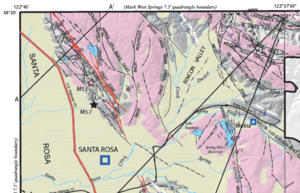1969 Santa Rosa earthquakes facts for kids
| UTC time | Doublet earthquake: |
|---|---|
| 1969-10-02 04:56 | |
| 1969-10-02 06:19 | |
| ISC event | |
| 803001 | |
| 803006 | |
| USGS-ANSS | ComCat |
| ComCat | |
| Local date | October 1, 1969 |
| Magnitude | 5.6 and 5.7 Mw |
| Depth | 9.6 km and 10.4 km |
| Epicenter | 38°28′01″N 122°41′31″W / 38.467°N 122.692°W |
| Areas affected | United States (Santa Rosa) |
| Max. intensity | VII (Very strong) VIII (Severe) |
| Aftershocks | Yes |
| Casualties | 1 dead |
On October 1, 1969, two strong earthquakes hit Santa Rosa, California. The first one happened at 9:56 PM, and the second at 11:19 PM. These earthquakes had magnitudes of 5.6 and 5.7. One person sadly died, and many buildings were damaged. The shaking was so strong it was rated 'Very Strong' and 'Severe' on the Mercalli intensity scale. The damage cost about $8.35 million, mostly to fix or rebuild broken buildings. After the main quakes, over 200 smaller shakes, called aftershocks, followed. At that time, these were the biggest earthquakes to hit the northern San Francisco Bay Area since the huge 1906 San Francisco earthquake.
Contents
Why Earthquakes Happen in California
To understand why these earthquakes occurred, we need to look at how the Earth's surface moves. The Earth's outer layer is made of large pieces called tectonic plates. In northern California, two main plates meet: the North American Plate and the Pacific Plate. They slide past each other along a huge crack in the Earth's crust called the San Andreas Fault.
This sliding motion isn't smooth. It causes a lot of stress in the ground. Because of this, there are many other smaller cracks, or faults, that run parallel to the San Andreas Fault. These faults also help release the stress as the plates move.
The Faults Near Santa Rosa
The 1969 Santa Rosa earthquakes happened along a fault called the Healdsburg Fault. This fault is located between two other important faults: the Maacama Fault and the Rodgers Creek Fault. These faults are all connected and are part of a larger system that extends north from the Hayward Fault Zone in the San Francisco Bay.
The 1969 Earthquakes in Detail
The two main earthquakes in 1969 happened very close to each other, only about a kilometer apart. They were a few kilometers north of Santa Rosa, right near the Healdsburg Fault. The earthquakes started about 9.6 to 10.4 kilometers deep inside the Earth.
The first earthquake was described by people living there as "violent" or "explosive." The main shaking from this quake lasted for about 15 seconds.
| Earthquake Location | Coordinates |
|---|---|
| First earthquake | 38°28.4′N 122°43.0′W / 38.4733°N 122.7167°W |
| Second earthquake | 38°27.9′N 122°43.1′W / 38.4650°N 122.7183°W |
How the Earthquakes Caused Damage
The earthquakes caused serious damage in parts of Santa Rosa. Many buildings were affected, chimneys fell down, sidewalks cracked and buckled, and underground water pipes broke. Luckily, very few people were hurt or killed. This was mainly because the earthquakes happened at night, when most people were not out walking in the streets.
The amount of damage was actually more than expected for earthquakes of this size. Many older buildings were so badly damaged that they could not be repaired. Scientists later found that Santa Rosa is built on two areas of soft ground, called sedimentary basins. These basins can make earthquake shaking much stronger, especially in certain spots where Santa Rosa is located. This explains why the damage was so severe.
Learning from the Earthquakes
After the 1969 earthquakes, Santa Rosa learned a lot about making buildings safer. The city decided to improve its building codes to make structures more resistant to earthquakes. This process is called "retrofitting." It involves adding features like strong supports or braces to older buildings, especially those made of unreinforced brick.
One of the first buildings to be retrofitted was the St. Rose Church and its Parish hall. This was because many people used these buildings, and they needed to be extra safe. The new safety rules adopted in Santa Rosa in 1970 became a model for other cities in California. Later, the entire state brought in similar requirements for making buildings safer from earthquakes.
Studying the damage in Santa Rosa showed experts that buildings need to be designed to handle the actual movement and forces of an earthquake, not just a simple push or pull. This was a big step forward in earthquake-safe building design, even for earthquakes that are not super strong.


